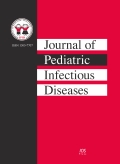Authors: Broughton, Simon | Zuckerman, Mark | Auburn, Helen | Smith, Melvyn | Fox, Grenville | Greenough, Anne
Article Type:
Research Article
Abstract:
Human meta-pneumovirus (hMPV) and rhinovirus (RV) lower respiratory tract infections (LRTIs) may result in acute symptoms similar to those of respiratory syncytial virus (RSV) LRTI. We, therefore, tested the hypothesis that other viral LRTI, as RSV LRTI, will increase healthcare utilization and chronic respiratory morbidity in prematurely born infants. One hundred and twelve prematurely born infants were followed prospectively. Hospital admissions and general practitioner (GP) attendances were recorded and cough and wheeze
…documented by diary card. Nasopharyngeal aspirates (NPA) were obtained for every LRTI and analyzed to identify RSV (A and B), hMPV, RV, parainfluenza (1 and 2) and influenza (A and B) viruses. Eighty-four infants suffered 126 LRTIs; 94 viruses [41 RSV, 36 RV, seven hMPV, five parainfluenza (1, 2 or 3) and five influenza (A or B) viruses] were identified from 82 of the 126 NPAs. Compared to the no viral LRTI group, infants with only RSV infection had more (P=0.038) and longer (P=0.045) hospital admissions, more GP attendances (P=0.024), more cough (P=0.030) and wheeze at follow up (P=0.018). If infants with dual infections are also considered, however, infants with a hMPV LRTI, with or without other viral RNA being detected, compared to the no viral group, had more hospital admissions (P=0.005), longer admissions (P<0.001), more GP visits (P=0.029), more days of cough (P=0.008) and more days of wheeze (P=0.004). RSV and possibly hMPV, but not RV, LRTI increase healthcare utilization and respiratory morbidity in prematurely born infants.
Show more
Keywords: Respiratory morbidity, viral infections, preterm delivery
Citation: Journal of Pediatric Infectious Diseases,
vol. 1, no. 4, pp. 205-211, 2006
Price: EUR 27.50





